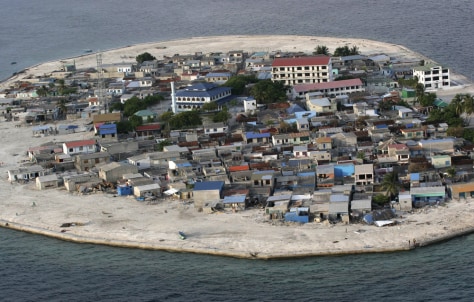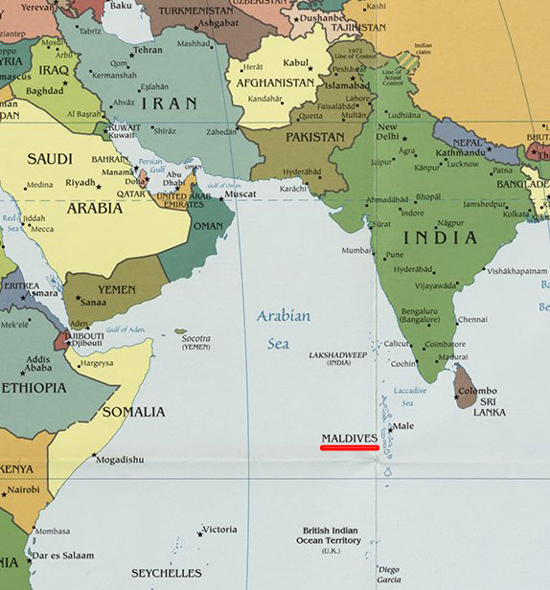Years ago, I had come across some photos of the
Maldives islands. I had never heard of this island group located in the Indian
Ocean. Pristine beaches, turquoise seas, sun, palm trees, exquisite resorts.
Who wouldn’t be interested in that? For years this small, almost unknown
country has been on my bucket list. It would be really expensive to visit
though; the flight alone would be over $9000 for the four of us. Even at that,
perhaps there’s still a way I can figure out how to “work from home” from the
Maldives. For a while at least.
The name Maldives may derive from a number of
sources, almost all of them from various Indian languages with the exception of
perhaps Arabic and Persian. Many of these meanings are centered around “garland
islands” but some older texts refer to it as the “hundred thousand islands.”
However, the English word is derived from the Dutch.
The Maldives Islands are a group of 1190 islands
and atolls in the Indian Ocean. The northernmost islands are a little less than
300 miles southwest of the Indian subcontinent. They’re also about 466 miles
southwest of Sri Lanka and separated from both India and Sri Lanka by the
Laccadive Sea. A little over 1900 miles to the west is Somalia on the Horn of
Africa. The southernmost islands are about 750 miles north of the US-owned
Diego Garcia Military Base on an atoll that is part of the British Indian Ocean
Territory (if you read the Google reviews on this base, it’s full of conspiracy
stories about the missing Malaysia Airlines plane being here). Because the
Maldives are in a tropical climate, they basically have two seasons: dry season
and rainy season.
The earliest peoples mostly came from the Indian
subcontinent and Sri Lanka with a few coming from other areas of Southeast
Asia. The Sinhalese arrival signified a change in the culture of the Maldives,
and the Dhivehi language was developed during this time as well. The islands
went through several religious periods in their history: the earliest peoples
practiced a form of Hinduism. Then the first kings promoted Buddhism. By the 12th
century, the islands converted to Islam, often attributed as part of the work
of a Moroccan traveler by the name of Ibn Batutta. Who exactly he was is up for
historical dispute, but his work stuck with the people here. The islands became
a stopping point for trade between Africa, the Middle East, Europe and
Southeast Asia. By the late 1880s, the British and the Maldives signed a
contract agreeing to allow the Maldives become a British protectorate. This
contract allowed the British to provide military protection while maintaining
local non-interference in exchange for an annual tribute payment. In a
disagreement with the government, the three southernmost atolls broke off and
started its own country, United Suvadive Republic. However, it rejoined the
rest of the country four years later. Two years after this, the island nation
gained its full independence from Britain, and later became a republic with a
king rather than a sultan. During the 1970s, tourism began to become an
economic focus. Several coup attempts during the 1980s finally led to the
intervention of the Indian Army. The country was devastated after the 2004
tsunami that resulted from the earthquake. An estimated 108 people died and 57
islands had severe damage to its infrastructure. A series of changes in
government and its economic policies occurred during the latter part of the
2000s and is still continuing today.
 |
| After the tsunami. |
The capital city is Malé, located on the southern
edge of the Kaafu Atoll. Originally, this was where the kings lived and was
called Mahal. After the monarchy was dismantled in 1968, the city was
completely rebuilt, and only the Friday Mosque remains as a remnant of that
time. Having a population of only 153,000, Malé is also one of the world’s
densest cities with about 46,320 people per square mile. (In comparison, my
city of Indianapolis has only 457 people per sq mi. New York City comes in at
26,403 people per sq mi.)
Much of their ancient economy was based on the sea,
mostly in the form of cowry shells, coir rope (pronounced “coy-yer”; made from
fibers of coconut), and tuna. The cowry shells actually used to serve as a
currency of sorts. Today, tourism serves as the country’s largest industry,
followed by fishing. The 2004 tsunami took quite a toll on its economy and its
government. For the first time, the government levied taxes on goods in 2008.
They also implemented certain social programs and a sovereign wealth fund from
the tourism dollars. The sovereign wealth fund is essentially a fund intended
to purchase land elsewhere in case they have to move due to rising sea levels.
The dominant religion in the Maldives is Islam, and
more specifically, Sunni Islam. Buddhism was once the major religion of the
area before the 12th century, and much of the artifacts left over
have been housed as museum exhibits. However, a few years ago Islamic
extremists launched an attack on Malé’s National Museum and destroyed much of
the artifacts in the pre-Islamic areas, leaving only two or three pieces that
might be able to be repaired. Today, it’s a fairly conservative country
strongly adhering to Islamic law; no other religions are allowed. Freedom of
the press is at a minimum, and the government will often side with religious
law over secular law. There is absolutely no alcohol, pornography, or
homosexuality.
The official language is Dhivehi, a relative of
Sinhalese and part of the Indo-Aryan language family. It’s used several scripts
over the past centuries and currently uses the Thaana script, which is read
from right to left. This script is pretty much only used for the Dhevahi
language and is roughly based on an Arabic script. Because of its history with
Britain, English is also widely understood and often used in the government,
education, and in commerce. The word “atoll” is said to be the only word in
English derived from a Dhevahi word.
The sea is highly integrated into the Maldivian
culture. It’s the lowest country in the world: the highest point is only 7’ 7”
above sea level and is 99% water. Because of this, the country is worried about
sinking into the sea with the rising sea levels from climate change becoming
more and more inevitable. Countries like Kiribati and the Marshall Islands have
already felt this impact. In fact, Maldivian officials held a Cabinet meeting
underground in 2009 to raise awareness of the growing reality of climate
change. All the climate change deniers should speak with the people from these
countries. I would like to think it might change their minds, but it probably
won’t. So, we better enjoy their culture now. Who knows if the islands will be
around in another hundred years?
Up next: art and literature






No comments:
Post a Comment